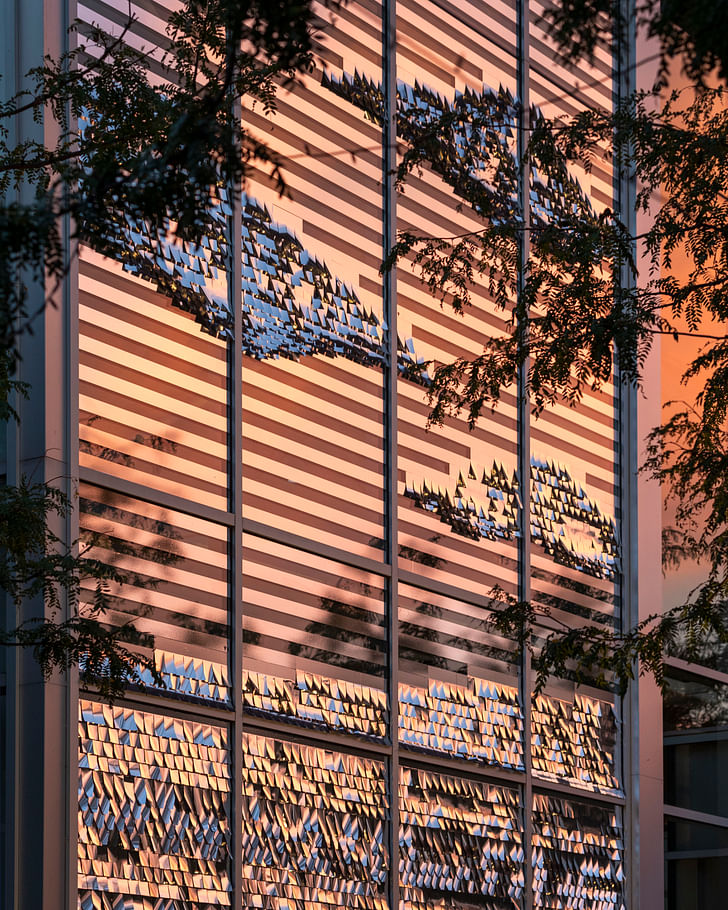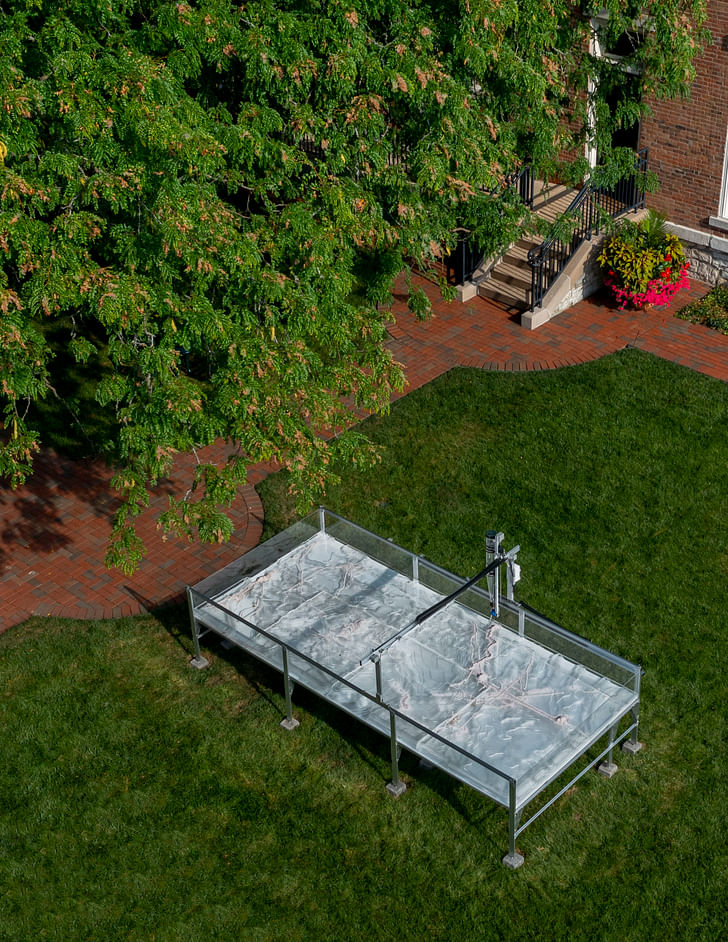

For the past several months, a small, Midwestern city located "in the middle" of the country has taken the architecture world by storm. Since the opening of Exhibit Columbus this past March, the exhibition team, designers, and curatorial duo Mimi Zeiger and Iker Gil have created an immersive, in-person experience teeming with work that embodies the past, present, and future of Midwestern architecture, research, and discourse.
As media partners, Archinect has conducted several interviews where we dive into the minds of the Exhibition's talented designers. We've learned how they've pushed the boundaries of site-specific architectural exhibitions and how they evoke moments of reflection and pride for cities in the Midwest.
In preparation for Exhibit Columbus' upcoming event, Mapping the Middle: Design Research Conversations, we were given access to dive into the projects of this year's seven University Design Research Fellows. The Exhibit Columbus team shared that this new colloquium invites each Fellow to discuss how their work "uses mapping as a tool/process to examine, reveal, and represent the world around us" while responding to the Exhibition's overall theme.
*Seven University Design Research Fellowships have been awarded to leading professors of architecture, landscape architecture, and design from American universities who will create installations highlighting their research. University Design Research Fellows were selected for their ability to tackle specific sets of issues germane to the future of the city and the Mississippi Watershed region, such as sustainability and material reuse, non-human habitat, watershed ecologies, emergent technologies, and migration.
This year's program of talented architects, designers, and academic provocateurs reminds us that existing architecture and discourse doesn't only happen in bustling cities and metropolises. In our previous conversation with curators Iker Gil and Mimi Zeiger, they express the importance of directing the spotlight to "the middle." Zeiger previously shared with Archinect, this year's theme was also for "the folks who are outside of Columbus looking in. Trying to figure out what is the meat of architecture given everything that’s going on right now."
Below are project images and brief descriptions of each research project along with links to full-length video presentations from each Fellow. In each video, they discuss their work and design process.

Window Dressing by Ang Li of Northeastern University
"Window Dressing is a façade installation along the Washington Street face of The Commons that invites the public to reflect on the cultural and architectural legacy of Late Modernism." (Listen to Li discuss her project in full here.)
Tracing Our Mississippi by Derek Hoeferlin of Washington University in St. Louis
"Tracing Our Mississippi will be an interactive installation and public programming series at the site of the Columbus Pump House, on a terrace adjacent to the Flatrock River [...] Hoeferlin’s project in Columbus and ongoing research presents the question: Is the Mississippi Watershed really a watershed anymore?" (Listen to Hoeferlin discuss his project in full here.)
To Middle Species, With Love by Joyce Hwang of the University at Buffalo
"To Middle Species, with Love is designed to amplify habitat conditions for urban wildlife in Columbus and bring increased visibility to their presence among us, as co-inhabitants of the built environment. These animals—which we call 'Middle Species' in contrast to 'flagship' species—are common and embedded in our communities: bats, birds, reptiles." (Listen to Hwang discuss her project in full here.)

LaWaSo Ground by Jei Jeeyea Kim of Indiana University
"LaWaSo Ground is a contemporary memorial and a community ground of (La)nd, (Wa)ter, and (So)il designed to help bridge some of the cultural dichotomies of our time through the lens of material culture. Sited on the lawn of First Christian Church, the installation draws from an acknowledgment of the silenced and suppressed voices of the past, and advocates for more diverse inclusion in the future." (Listen to Kim discuss her project in full here.)
Spectral by Ersela Kripa and Stephen Mueller of Texas Tech University at El Paso
"Spectral addresses the legacy of aerial activity above the city and speculates on a future in which urban spaces are cognizant of their engagement with aerial imaging technologies [...] Spectral is designed as both a public gathering place and a meditation on how and what is seen has changed from projected light (the movie theater) to increasingly pervasive aerial infrared imaging" (Listen to Kripa and Meuller discuss their project in full here.)
This Appearance Is _____ by Lola Sheppard and Mason White of University of Waterloo & University of Toronto
"This Appearance Is ____ invites citizens into the space of appearance and disappearance. [...] The installation is a study in the ability to retreat from and then rejoin the larger world—a test made all the more poignant after more than a year of pandemic restrictions." (Listen to Sheppard and White discuss their project in full here.)

Calibrate by Natalie Yates of Ball State University
"Calibrate is an apparatus for registering and perceiving multiple scales of intricate, accumulated environment data gathered from across Columbus and its environs. The installation records the cultivated ecological layers of a city rich in the making, creativity, and innovation over multiple, disparate timescales from geologic time to real-time sensing data." (Listen to Yates discuss her project in full here.)
After following the Exhibition over the last several months, I'm left with two thoughts. First, the 2021 iteration of Exhibit Columbus has allowed me to develop a new perspective of the Midwest. While it's easy to criticize exhibitions from afar, my only critical comment is wishing the exhibition lasted longer so I could see the installations in person. It's clear that each participating designer has presented the city of Columbus with a tangible gift that adds to the city's architectural landscape. The Exhibition provides a "call to action" for individuals to pay closer attention to architecture discourse happening in the Midwest region. Each installation and subsequent panel discussion acts as a "call to be" with architecture. To sit with architecture and experience how this discipline impacts cities big and small.
'New Middles' has prescribed the design community a renewed reason to experience space, listen to discourse and develop improved perspectives.
My second takeaway focuses on the power of site-specific exhibitions. While the general public may view them as "exciting events" to visit on the weekend or opportunities for capturing photogenic projects, programming like Exhibit Columbus acts as invitations to the public. This sense of inclusion was accomplished thanks to the Exhibition's planning team and the skillful intentionality of curators Gil and Zeiger. They've managed to give the community a series of works to get lost in, ponder over, and applaud. "New Middles" has prescribed the design community a renewed reason to experience space, listen to discourse and develop improved perspectives. All the while, it's invited the general public with a chance to view representations of architecture discourse that is often held within the confines of academia and elite architecture circles.
Exhibit Columbus, its curatorial team, designers, and collaborators had created an exhibition that not only endured a challenging year but set a marker for what can be done when the very nature of architectural discourse was changing and being challenged. If you're in the Columbus area, be sure to visit Exhibit Columbus and Saturday's event Mapping the Middle: Design Research Conversations on October 2 from 1:30 pm - 5:00 pm at First Christian Church courtyard.
The 2021 Exhibition will be on display from now until November 28, 2021. To learn more about "New Middles" and its programming, click here.
Katherine is an LA-based writer and editor. She was Archinect's former Editorial Manager and Advertising Manager from 2018 – January 2024. During her time at Archinect, she's conducted and written 100+ interviews and specialty features with architects, designers, academics, and industry ...
No Comments
Block this user
Are you sure you want to block this user and hide all related comments throughout the site?
Archinect
This is your first comment on Archinect. Your comment will be visible once approved.